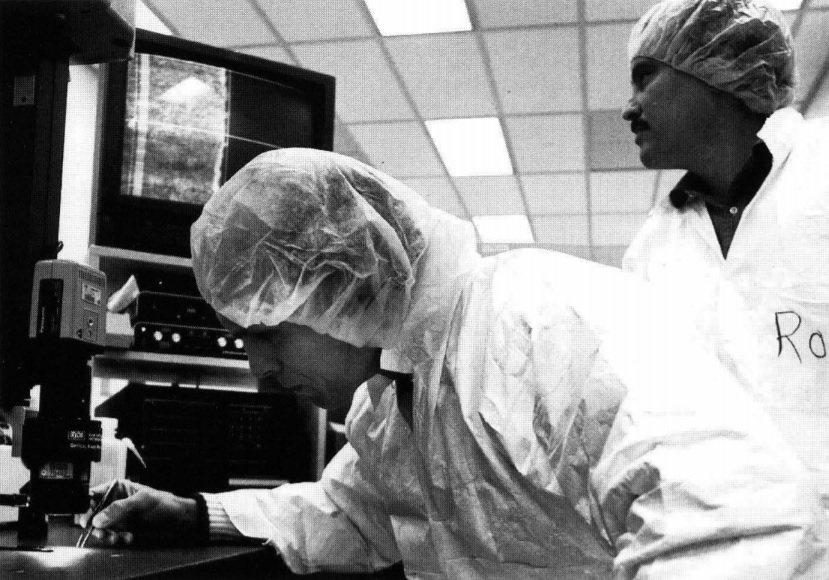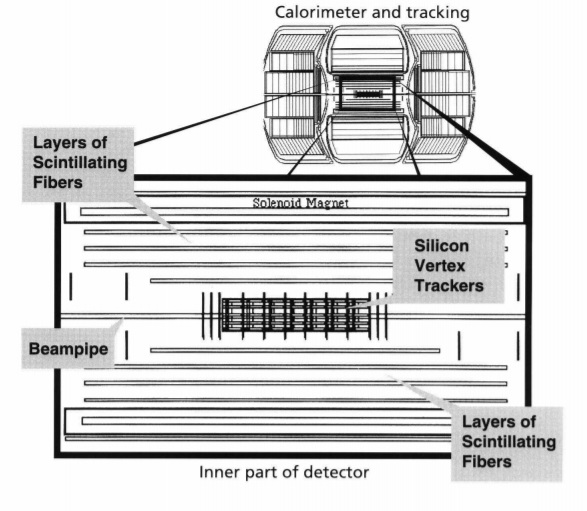CDF and DZero: Working Together to Advance Detector Physics
As Fermilab prepares for the future in high-energy physics, the Laboratory must maintain a certain synergy. If technology and engineering advance in one field, other areas must progress in parallel, as with the DZero and CDF experiments and their future benefactorthe Main Injector.
The Main Injector, which will begin operating by 1999, will greatly increase the luminosity of the Tevatron, resulting in many more collisions per second at DZero and CDF. Without upgrades, the detectors at the two experiments would not be able to keep up with the higher luminosity, and all those extra collisions would be for naught.
"Detectors have to keep up with the accelerator to achieve more precision in the physics measurements that we are making," said Ron Lipton, a DZero experimenter and head of his experiment's silicon detector project.
These studies include "better measurements of the mass of the top quark, [and] more accurate measurements of the intermediate bosons, which are carriers of the electroweak force. All of those things benefit from having higher luminosity..."
Because upgrading the detectors is a laborious and expensive task, requiring great expertise in multiple fields, CDF and DZero are cooperating on the project. When scientists complete the upgrades, components in the two detectors will be different in detail but similar in concept and development. Both experiments are using a common facility for silicon detector construction, a common engineering staff to design them, and a common electronics development effort as well, according to Lipton.
"It is really important... to understand that the two experiments have worked together to build the infrastructure of the detectors," said Lipton.
"The Laboratory just can't afford to build many independent, similar devices. It is just too expensive in terms of dollars, but mostly in terms of manpower, expertise and technical abilities. And so I think the cooperation has worked out [fairly] well."
Jim Hylen, a CDF physicist and head of his experiment's scintillating fiber project, agreed and said the sharing of knowledge has greatly benefited CDF.
Of the many facets to the upgrades of the two experiments, some of the most ambitious involve the two inner layers of detectors-the silicon vertex tracker and scintillating fiber technology, according to Lipton.
CDF developed much of the technology for the silicon vertex tracking, and DZero pioneered the development of the scintillating fiber tracking system.
Silicon Vertex Detector
A silicon vertex tracker, made possible by technology that grew out of the microelectronics industry, consists of a piece of silicon with microscopic detector strips imprinted directly on it. The strips are sensitive to particles passing through them. Technicians connect sets of 128 strips to a SVX chip with a wire thinner than a human hair. Scientists and engineers from both Fermilab and the Lawrence Berkeley Laboratory in California developed the SVX chip.
As a particle passes through the detector, it knocks out electrons that the microstrips collect; this is the "signal" of the particle. The signal then goes through the wire to the chip. The chip amplifies the signal, then delays the charge. A "delay" stores the event information for 32 collisions; this infinitesimal amount of time gives the trigger hardware a chance to analyze the event and decide if it should be kept. The trigger will generally keep one interesting event out of approximately 1,000 total events.
If the event is worth keeping, the SVX chip turns that charge into a digital number, and a computer converts the digitized information to a readout that physicists can study.
When silicon vertex trackers were first used for experiments at the Large Electron Positron collider at CERN, each separate silicon detector had 40,000-50,000 "channels" for detection.
The detectors now being developed for CDF will have about 400,000 channels per detector, and the DZero version will have about 800,000 channels, allowing much more precise measurements than any seen in the past.
"In the end, when you display a track coordinate, a single piece of information about that track coordinate is contained in that one channel of electronics. So, the more channels you have, the more detail [you] can measure about the tracks," said Lipton.
Scintillating Fiber Technology
The next layer of detectors after the silicon vertex trackers is the scintillating fiber. Technicians weave fibers together in a very precise array of ribbons and then place the ribbons and their mountings onto cylinders. When a particle passes through, a brief flash of light occurs. That light travels down an optical fiber, similar to the kind used in telecommunications. The light then hits a Visible Light Photon Counter. The VLPC changes the flash of light into an electrical signal for a better reading and then converts the signal to digitized information. A computer translates that data into information physicists can study. Scientists keep the VLPC very cold because it is sensitive to thermal "noise" generated by heat.
The scintillating fiber is not as fine grained as the silicon, but more fine grained than the next layer of detectors in CDF, the wire drift chambers, said Hylen.
Rockwell International Corp. developed VLPC technology for the military, and Fermilab staff helped adapt it for the Laboratory.
Displaced Vertex
A goal of the new detector technology will be to pinpoint the "displaced vertex" of a particle. This technique enables scientists to track a particle back to where it first decayed. A particle often decays before it gets out of the vacuum pipe and hits the first detectors. Physicists use the displaced vertex to find out where the particle first decayed by "retracing" its steps. CDF has used this technique in the past, but DZero did not previously have the technology to exploit it. With the upgrades, both experiments will be able to use the displaced vertex technique.
Other Upgrades
Along with the inner layers of the detectors, other components of CDF and DZero will be getting upgrades. For example, scientists in DZero are developing a new muon system to measure muons that don't pass through the entire steel system. DZero and CDF are also revamping the calorimeter electronics system and other electronics components to keep up with the higher luminosity generated by the Main Injector.






